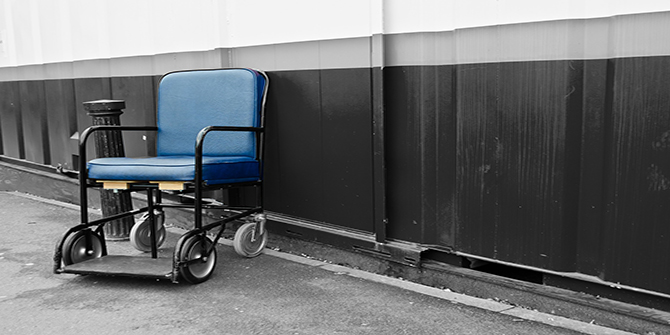Power is something we are often uncomfortable naming and talking about explicitly. In our everyday talk, power has a negative moral vibe: power-mad, power-hungry, power trip. But power is no more inherently good or evil than fire or physics. It just is. The only question is whether we will try to understand and harness it. In the culture and mythology of democracy, power is supposed to reside with the people.
Here’s a simple definition of power — it’s the capacity to ensure that others do as you would want them to do. Civic power is that capacity exercised by citizens in public, whether in elections or government or in social and economic arenas. Power in civic life takes many forms: force, wealth, state action, ideas, social norms, numbers. And it flows through many conduits: institutions, organizations, networks, laws and rules, narratives and ideologies. Map these forms and conduits against each other, and you get what we think of as “the power structure.”
Story is the catalytic agent for changing the status quo.
The problem today is that too many people aren’t able to draw, read or follow such a map. Too many people are profoundly illiterate in power (TED Talk: Why ordinary people need to understand power). As a result, it’s become easier for those who do understand how power operates in civic life to wield a disproportionate influence and fill the void created by the ignorance of the majority.
The powerful tell tales about why they deserve their status, so that they can feel better about it. So do the powerless. Together, these two sets of stories form an unseen prison of the imagination that shrinks everyone’s scope of possibility about alternative arrangements and allocations of power.
When you want to challenge the powerful, you must change the story. You can use story to organize people and then allow them to organize themselves into the story. Your narratives have to offer an alternative to the dominant story line of why things are the way they are. You have to stir up a new sense of “us”; provide an overarching explanation for who has what and why; and awaken the hero’s spirit in every citizen. Story is the bonding agent in social cohesion. It is the catalytic agent for changing the status quo.
Organizing people centers on telling three nested narratives: the story of self, the story of us, and the story of now.
Marshall Ganz, learned his art as a civil rights worker in Mississippi in the 1960s, then went on to organize migrant farmworkers with Cesar Chavez. He developed the organizing tools and strategies used by the first Obama presidential campaign and has mentored countless social-justice organizers around the planet. He teaches now at Harvard, where, 28 years after dropping out of college, he returned to finish his degree and get a doctorate. He is the quintessential teacher-as-learner.
Everywhere he goes, Ganz uses a method for organizing that centers on three nested narratives: the story of self, the story of us, and the story of now. He teaches organizers entering into any setting to start not with policy proposals or high concepts like justice but with biographies — their own, and those of the people they hope to mobilize.
What are the stories you tell about yourself? Why do you tell them that way? How can we find connections across our stories of origin that build trust and common cause? That work then flows into the story of us: the collective narratives of challenge, choice and purpose that emerge from any community — that, in fact, help define it.
This is how in a place like New Orleans after the flood or Detroit after the crash, residents can develop a shared identity of resilience and reinvention. It’s how a political party is able to motivate and mobilise for change.
Once that shared narrative is activated, the organizer can connect it to the fierce urgency of now: a story about why this is the “movement moment,” when individual and collective motivations converge, and when action is needed and possible. Why this and no other time is the time for change. This is how “Yes We Can” became more than a slogan in 2008, as “Morning in America” did in 1980. Or “Make America Great Again” did in 2016.
Stories are weapons in an endless contest for legitimacy.
Of these three stories, the middle one — about us — is crucial. Any effort to exercise citizen power depends on creating new answers to the question: Who is “us”? During the campaign for a $15 minimum wage in Seattle, one of the most potent speeches was from a woman named Evelyn, a sixty-something Filipina immigrant who cleans rooms at a Sea-Tac Airport hotel.
It was a fund-raising event for the campaign, and this was her first public speech. And though she’d never heard of Marshall Ganz before, in her short and blunt remarks she intuitively hit each of his marks. She talked about how a higher wage would enable her to catch up on her bills (self). She talked about why this was a unique opportunity to make gains for working people (now). But she was at her most effective when she talked about what kind of Seattle we wanted to be, and why the city would be stronger if the people who do the thankless work could afford to live there, too. In short, she redefined us. She redrew the circles of identity, not as low-wage workers versus high-wage workers but as people who hold true Seattle values of inclusion versus those who don’t.
This redrawing of the circles is also how “deep canvassing” — intensive face-to-face front-porch conversations based on personal storytelling — can change minds and win adherents on contentious issues like gay and transgender rights.
Two young political scientists, Joshua Kalla of Berkeley and David Broockman of Stanford, have conducted pioneering field experiments on deep canvassing. One of the strategies that they found most effective was “analogic perspective taking,” in which canvassers would invite citizens to talk about times when they’d been treated unfairly for seeming “different.” From there, the canvasser could pivot to what those citizens had in common with gay or transgender people, and could often awaken enough empathy to reduce bias.
This is more than stepping into someone else’s shoes — it’s stepping into the story of how someone else came to be wearing those shoes.
If you are trying to convince your neighbors that a nearby church should be allowed to host a temporary homeless encampment, how do you deploy story? Sometimes, it might be by deriding the selfishness of those who resist. More often, it will be by appealing to the better angels of all, so that even resisters can join without losing face.
Either way, you are crafting an imagined us in order to create a real majority. In a town with excellent schools that attracts young families, how do you deal with the divide between the newcomers who are driving up property values and the old-timers who don’t have school-age kids and want lower taxes? Again, you create a story of us, of common interest, that will either transcend that divide or sharpen it in a way that isolates the holdouts.
Such stories are weapons in an endless contest for legitimacy.
The forthcoming General Election is already over, not won by the Conservatives so much as lost by Labour who have allowed the Tory narrative to prevail.
“We can do better. We can be better. Now.” Is essentially the Labour narrative. It is now and always has been the same story and Labour needs to stick to it rather than [playing the fear blame game that the Tories prefer.
We can do better by our elderly, better healthcare, better social care. Because my nan deserves better and so does yours.
We can do better by our children, better schools and universities. because my children got to university and so should yours, or maybe to an apprenticeship scheme, or straight into a job because that’s what was right for them.
We can do better by our friends and neighbours. We don’t have to be aggressive and nasty to our neighbours, our trading partners in the EU. We can be kind, gentle and generous to the newly arrived amongst us because we are better than the alternative.
We are better than mean and nasty.






